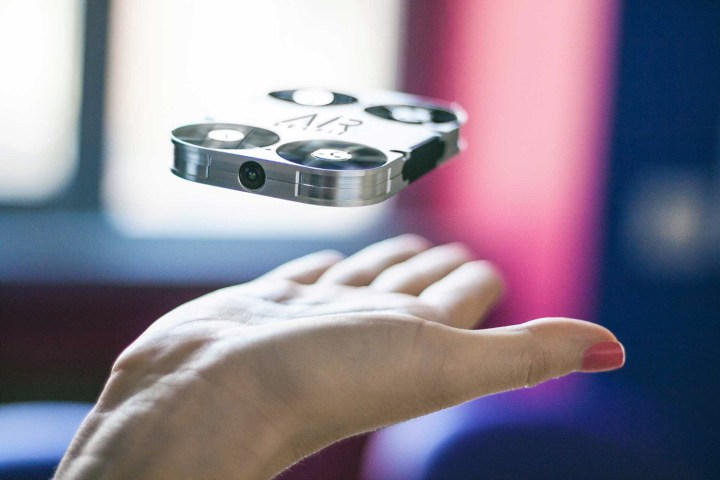
Freedrum — Portable, virtual drum kit
Want to get your John Bonham on, but don’t have the necessary space (or cash) for a real drum kit? Not to worry — Freedrum is just what you’ve been waiting for. You know those digital drum sets that you can link to your a pair of headphones and play beats that only you can hear? Freedrum is the same thing — except it doesn’t have any physical drum pads for you to hit. The entire experience is virtual — you just strap a pair of sensor packs on your sticks and go nuts.
Under the hood, Freedrum boasts a bevy of smart sensors. In a nutshell, the system uses finely-tuned gyroscopes and an accelerometers to determine several parameters –things like where you’re drumming, or how hard you’re hitting each drum–, based on angles and velocity. This data is translated into “hit areas” which can then be programmed to create your desired sound via an accompanying Bluetooth app. The setup is powered by a miniature, high-capacity LiPo battery, which can be charged in under an hour, and will keep your drumsticks charged for seven hours of continuous drumming.
AirSelfie — Pocket-sized selfie drone
Drones have come a long way in the past few years, but now that manufacturers have managed to stuff them with all the bells and whistles we could ever want, the race is on to shrink them down and make them more portable. Thanks to the proliferation of smartphones, compact sensors, cameras, and processors are more accessible than ever — and now those same components are being used to build a new generation of ultra portable — but still very capable — mini drones.
AirSelfie is the latest addition to this burgeoning category. It’s a selfie drone — which isn’t really a new idea at this point, but this one is particularly slim, pocket-friendly, and portable. Thanks to its slim profile, the drone can slip into a case that’s no bigger than a fat smartphone. To fly it, just toss it in the air, steer it into place using the accompanying smartphone app, and start snapping pics. With an integrated camera that shoots five-megapixel stills or HD video, it’s basically a flying photographer that fits in your pocket.
Kaffee — Coffee table with integrated fireplace
Good news, pyromaniacs! Thanks to miracles of modern technology, there’s finally a way to light a fire on your coffee table without burning down your apartment. Kaffee, as it’s called, is a stylish new coffee table that features a built-in flame generator and you can switch on at the push of a button. It’s designed for people who love the warmth and aesthetic feel that a fire provides, but don’t have the luxury of owning a traditional fireplace.
“You can think of it like a big Zippo,” co-founder Randall told Digital Trends. “It uses commercially available fuel which runs smoke- and fume-free, so that it doesn’t require any ventilation if you burn it inside. You don’t have to install air ducts, a chimney, or anything like that. The fact that it’s so optimal for indoor environments is the reason we decided it would be perfect as a centerpiece for furniture.” In terms of heat, the table pumps out around 5,000 BTUs of heat, which should make a noticeable difference in even the most respectable of living rooms. Its design is also suitably clean and minimalist — with a glass and steel enclosure that won’t look out of place among your other gadgets.
Rocketbook Everlast — Reusable analog notebook
Do you burn through notebooks and find yourself constantly having to buy new ones? Rocketbook might be just what you need. The notebook is designed to be completely reusable — paper and all. Once you fill up all the pages, the Rocketbook is able to digitize all your notes and store them in the cloud, and then clear all the pages so you can write on them again. The pages of the notebook (which are just regular-ol’ paper, by the way) feature a set of seven different symbols, which can be mapped to different cloud storage services. Mark one of the symbols on the page, and when you scan it with Rocketbook’s accompanying smartphone app, a digitized copy of the page will instantly be sent to the cloud storage platform of your choice.
After you’ve you’ve filled up the notebook and digitized all your notes, you can just pop Rocketbook in the microwave for 30 seconds and it’ll erase all your work — so long as you use a Pilot FriXion pen (they use ink that turns clear when you heat it above a certain temperature). The Rocketbook actually popped up on Indiegogo a couple years ago, and now the creators have taken to Kickstarter to gather up funds for a bigger production run.
Vixole — Customizable LED sneakers
When you think of high-tech sneakers, your mind probably conjures up images of kicks that lace themselves up Marty McFly style — but footwear startup ShiftWear has a totally different vision for futuristic feet. Instead of self-lacing tech, the company has developed a set of sneakers that function as a sort of digital canvas — thereby allowing you to customize and adjust the look of your kicks to suit any outfit or occasion.
Kitted out with embedded sensors and flexible LED screens, the company’s high-tech Vixole kicks allow wearers to personalize their shoes by using them as miniature displays to show designs, animations, and photos sent from your smartphone. The shoe communicates with your phone using Bluetooth, so you can take a picture and upload it, draw your own design, or even — if you know how to code — write your own algorithm to make a neat visualization. If you play your cards right, you might not have to buy another pair of sneakers ever again!




